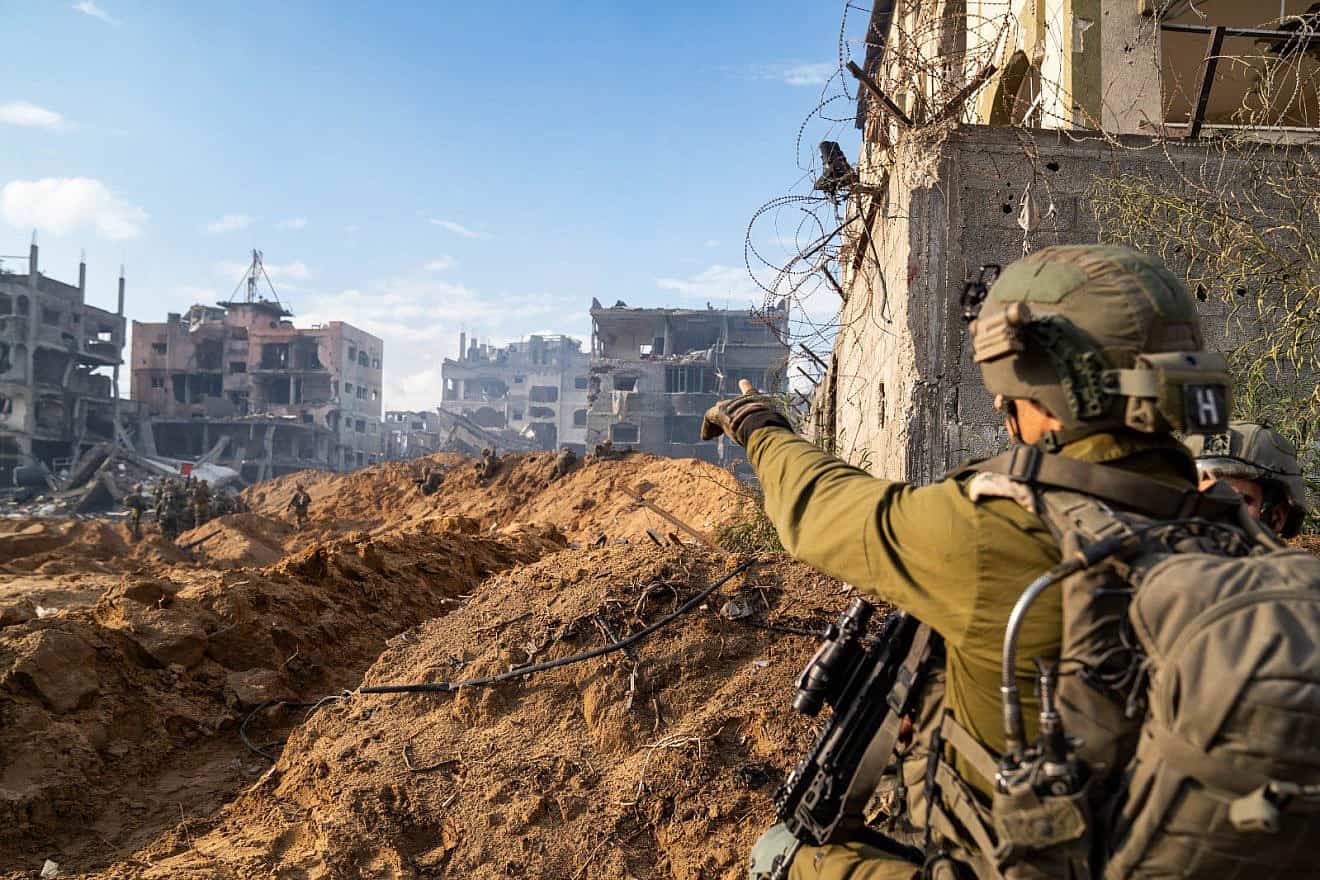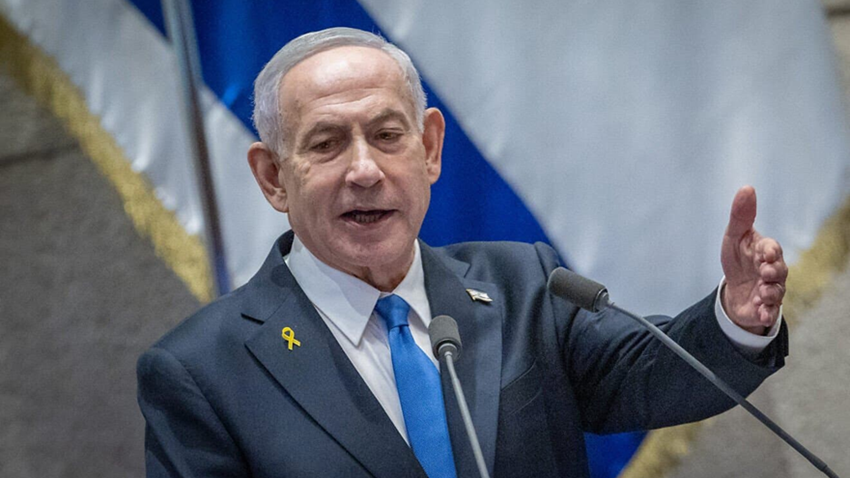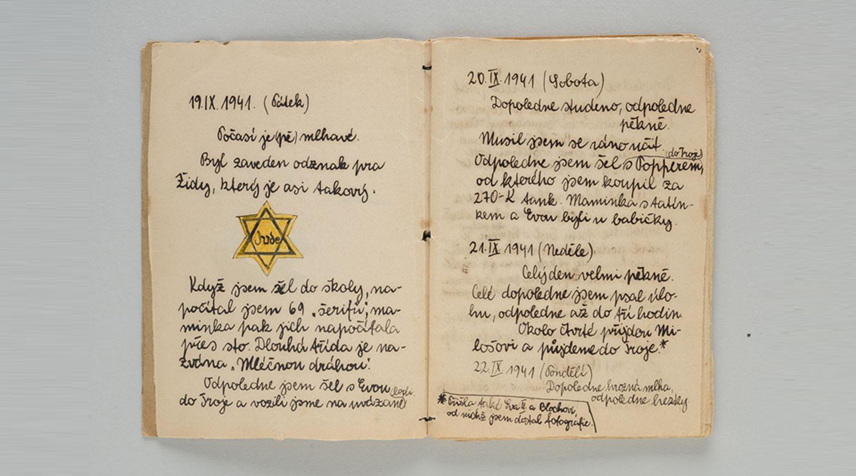Israeli troops operating in the Hamas-ruled Gaza Strip, Nov. 22, 2023. Credit: IDF.
On Oct. 7, on the Jewish holy day of Simchat Torah, Hamas took Israel by surprise with an attack it will never forget. Over 3,000 terrorists and Gazan civilians crossed into Israeli territory and committed the most heinous single-day massacre in the history of the Jewish state. Over 1,200 were killed, thousands more were wounded and as many as 240 were taken back to Gaza as hostages. Thousands of rockets were launched into Israeli territory.
The brutal attack was a declaration of war, and immediately Israel readied for battle. Devastating airstrikes on the Gaza Strip began within hours and continued for weeks. Soon after, tens of thousands of Israeli soldiers launched a ground incursion to target Hamas’s military leadership, uncover a vast underground tunnel network and weapons caches and search for the hostages.
The IDF’s entry into the Strip was the first time any Israelis had set foot in Gaza since Israel’s full military and civilian withdrawal from the area in 2005.
The Gaza Health Ministry—an organ of Hamas—accuses Israel of killing over 10,000 people and destroying tens of thousands of buildings since the beginning of the war. Gaza Health Ministry stats are unreliable, unverifiable and don’t distinguish between militants and civilians. Yet they give some indication as to how much damage Israel has wrought within Gaza.
The ground incursion began in the northern half of the narrow enclave. The IDF methodically moved south along the coast and then encircled Gaza City—the strip’s largest city—from the south. Gazan civilians heeded Israeli warnings and moved south along protected humanitarian corridors, emptying out the north so Israel could specifically target those seeking a fight.
Israel currently controls as much as a third of the Strip, and was beginning its move toward the south, where many of Hamas’ senior leadership are now believed to be operating.
Hamas needed a pause
Hamas has been taking a severe beating and desperately needed a pause in the fighting. Enter the hostages. With its terror militia on the run and its rocket supply rapidly dwindling. Hamas used its collateral, the hostages it took for just such a purpose, to convince Israel to halt its momentum.
Hamas dangled a promise to return 50 hostages for 150 convicted terrorists sitting in Israeli prisons and a four-day pause in the fighting. The two sides negotiated terms, which include the possibility to extend the ceasefire by an extra day for each additional 10 hostages Hamas can deliver alive.
Risk-reward scenario
For Israel, the terms represent a high-stakes risk-reward scenario. The
rewards are obvious and immediately tangible. The return of 50 hostages provides relief to many of the families who have been reliving the trauma of Oct. 7 for 50 days since the Simchat Torah massacre. The entirety of Israeli society wants the hostages home.
Yet the risks are also profound. The pause provides a terror group on the run a desperately needed opportunity to regroup, rearm and redeploy,
potentially placing IDF soldiers at greater risk when fighting resumes.
The prisoners Israel released back into society—at a 3-1 ratio—are terrorists, many convicted of attempted murder. Like prisoners released in the unconscionable 1,000-1 trade in 2011 to recover kidnapped IDF soldier Gilad Shalit—who was held in Gaza for five years—many are likely to commit new acts of terror following their release, threatening the lives of more Israelis.
(Hamas terror mastermind Yahya Sinwar was one of those released in the Shalit deal. Worse, Sinwar was treated and had his life saved in an Israeli hospital in 2007 after suffering from life-threatening neurological symptoms.)
And nobody can predict what the current trade might mean for the safety of hostages who remain in captivity after the initial deal.
Israel negotiated from strength
While all Israelis want the hostages back, not all support the dangerous
trade. Yet the War Cabinet, the full Cabinet and the Knesset all backed the deal. While opponents of the deal claim that Israel negotiated from a
position of weakness, the exact opposite is true. Israel negotiated the
hostage deal from a position of great strength.
First, the IDF is one of the world’s strongest militaries. It is absolutely destroying Hamas, with only a portion of its military might. Israel and Hamas both understand well that a four-day pause does little to
change Israel’s overall strategic advantage on the battlefield, even if Hamas manages to regroup and rearm.
Israel’s moral superiority
Second, in placing such a high value on retrieving its hostages, Israel has
once again demonstrated its moral superiority. While Hamas values
martyrdom and a culture of death, Israel values life, and will risk life and limb to save one of its own. That is a message being heard loud and clear inside Gaza, where civilians recognize that Hamas has invited death and
destruction into the Strip, and does little to protect its residents.
It is a message that is reverberating around the world as well. The return of Israeli hostages to the headlines reminds the international community that Israel was severely victimized on Oct. 7 by a brutal terror organization.
That Hamas has been essentially forced to give up 50-70 of its bargaining
chips for only 4-6 days of pause in the fighting demonstrates how
desperate a situation Hamas is actually in.
Netanyahu shames Hamas in Gaza
Adding insult to injury for Hamas was a surprise visit by Israeli Prime Minister Benjamin Netanyahu to the strip on Sunday, where he held situational assessments and met with IDF soldiers that continue to hold their positions.
Netanyahu’s visit sent clear messages both in Israel and Gaza. First,
Netanyahu has not-so-subtly signaled that as the head of the strongest
military force in Gaza, he is now the Strip’s sovereign leader. From this point forward, it is Netanyahu who will determine the fate of Gaza, not Hamas.
The visit is a terrible embarrassment to Hamas, and this is the reason they have not openly commented on it. The visit would have gone viral globally and been more difficult to ignore had Netanyahu opted to record statements in English, in addition to the statements he made in Hebrew while with the Israeli soldiers.
IDF pressure campaign to resume
Second, as Netanyahu repeatedly told the soldiers, as did Defense Minister Yoav Gallant in Gaza the day before, the military campaign will resume as soon as Hamas is no longer able to deliver hostages. Gallant has repeatedly insisted that it was IDF pressure that forced Hamas to negotiate the return of hostages, and he continues to insist that further IDF pressure will lead to the release of additional hostages in the days and weeks to come. The defense minister has stated that fighting in Gaza is expected to continue for months yet. Netanyahu and Gallant have no choice but to beat Hamas at its own game.
Understanding Hamas’s strategy
On Oct. 7, Hamas intentionally launched an attack so heinous that Israel
would have no choice but to retaliate on an unprecedented scale. And it is obvious that the IDF, as one of the world’s strongest and battle-ready
militaries, has enough might to defeat a terror entity with fewer soldiers and inferior weapons.
Hamas understood from the outset that it could never defeat Israel on the physical battlefield. Instead, it sought to use the physical war to defeat Israel on the psychological battlefield, and in the realm of public opinion.
A weakened and divided Israel?
In the weeks, months and even years leading up to the attack, Hamas and its backer, Iran, recognized severe political divisions inside Israel.
They believed bogus assessments by anti-government forces that the
divisions had weakened the military. Hamas believed that this supposed weakness would lead to mistakes on the battlefield that would further eat away at Israel’s waning cohesion.
Hamas also believed that their network of underground tunnels and stable of improvised explosive devices would create enough surprise launch points and booby traps to cause large numbers of Israeli casualties during a ground invasion. Hamas hoped such casualties would weaken Israeli determination to fight.
Hamas also hoped it could shut down the Israeli economy and homefront by firing thousands of rockets and constantly sending Israelis running to bomb shelters.
And, Hamas believed that by taking hostages, they could force Israel to
negotiate on highly unfavorable terms.
Provoking civilian casualties in Gaza
But most importantly, Hamas wanted the IDF to enter the densely populated (not one of the world’s most densely populated areas as many claim, but certainly dense enough) urban arenas in the hopes that Israel would kill as many Gazan civilians as possible. This in turn, they hoped, would cause the international community to turn on Israel, and further delegitimize the Jewish state.
For decades, Palestinians have aimed to delegitimize Israel, as their primary tool to harm the Jewish state.
A rude awakening
Yet Hamas’ strategy has not proven sound.
First, the attack on Oct. 7 was so heinous and so barbaric that even those who disapproved of years of Israeli policy toward Palestinians had little choice but to side with Israel and express their outright support for the full dismantling of Hamas. In the opening weeks of the war, Netanyahu ran a masterclass in international diplomacy, inviting the leaders of the free world to see the carnage for themselves, and recruiting their steadfast support.
Support has lasted for seven weeks already, much longer than Hamas would have hoped.
Once the ground fighting began, the IDF moved slowly and methodically through the Strip. While thousands of Hamas soldiers have been killed, Israel has lost significantly less than 100 soldiers, exponentially lower than what Hamas would have expected. Meanwhile, morale among the soldiers and trust in the battle plans has grown stronger with each day.
The IDF’s Iron Dome missile defense system shoots Hamas’s Kassam rockets out of the sky with over a 90% interception rate. Israel has successfully weathered the storm of rockets with very little damage and barely any casualties.
A gold standard for modern warfare
Furthermore, the IDF has gone out of its way not to harm civilians. To date, the IDF has done more to avoid civilian casualties in this conflict than any military in the history of warfare. Militaries will soon study Israel’s methods as the gold standard for conducting war.
Israel has been making its case on the international stage more strongly
than ever before. World leaders have no choice but to see the efforts Israel is taking to provide humanitarian aid, provide advance warning to residents ahead of strikes and guarantee safe corridors for travel out of danger zones.
At the same time, the world sees Hamas using residential neighborhoods, schools, mosques and hospitals as firing zones and military command centers in a desperate and obvious attempt to inflate civilian deaths.
Will Gazans flee the Strip?
Over 1 million Gazans have been displaced, and currently sit near the
Egyptian border. As the IDF continues to move south, there is likely to be increased international pressure to open the border and allow safe haven and even resettlement for Gazan residents that wish to leave the Strip.
Israeli cohesion
Perhaps Hamas’s largest miscalculation, however, was their wrongheaded assessment of Israeli cohesion, or lack thereof. While politics fueled by election cycles and a toxic media caused unceasing bickering in the Jewish state, the foundations of the nation remained strong. Rather than weaken the country, the Oct. 7 attack galvanized and unified the nation against a common enemy.
Israel is stronger today than it was on Oct. 6. Israelis are prepared for
the resumption of the military campaign following the pause, and support the military objective of dismantling Hamas and removing it from political power in the Gaza Strip.
Restoring deterrence
The severity of the IDF’s response in Gaza is obvious to
Iran its other terror proxies. As such, Hamas has not (to date) received the support it may have expected from its fellow Iranian proxy, Hezbollah in southern Lebanon. While Hezbollah has fired over 1,000 mortars and anti-tank guided missiles at Israel, they have hesitated to rush Israel with an attack that would draw the type of response now unfolding in Gaza.
A war about Iran, not Palestinians
That said, the border continues to heat up and a larger regional conflict
cannot be ruled out. From the beginning, it was assumed that Israel
preferred to tackle the terror threats at its borders one at a time, and it
appears that strategy is playing itself out.
Yet as Hezbollah, and Houthis in Yemen, attack Israel—the latter firing
ballistic and cruise missiles at the country and hijacking Israel-linked ships—the battle dynamic shifts further out of Hamas’s favor. With fighting predominantly localized in Gaza, the battle has been characterized until now as part of a protracted Israeli-Palestinian conflict.
As other Iranian proxies continue to ramp up their attacks, both on Israel and American installations throughout the Middle East, it becomes clearer that the war is not between Israelis and Palestinians, but between Israel and Iran via its numerous terror proxies.
The days ahead
Many unknowns remain, yet the pause in the war provides an important opportunity for assessment.
Hamas certainly did more damage on Oct. 7 than any Israeli would have
imagined, igniting the current conflict. Yet while Israel has been forced to fight Hamas on its own turf in more ways than one, Israel has responded with overwhelming military precision and force, diplomatic support and most importantly, domestic resolve.
On top of that, IDF pressure has forced Hamas to send more than 50 of its hostages home. May the rest come home in the days ahead.
Source: JNS



































